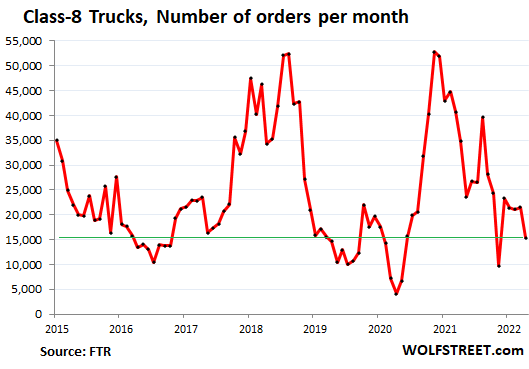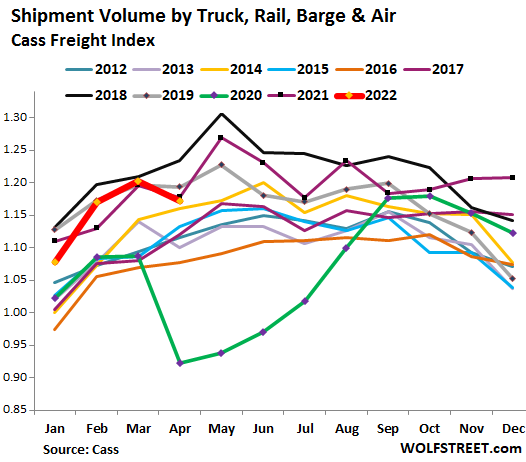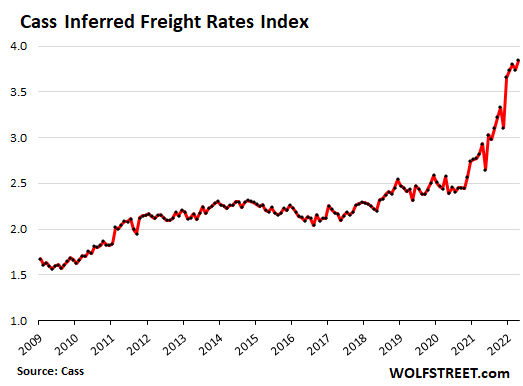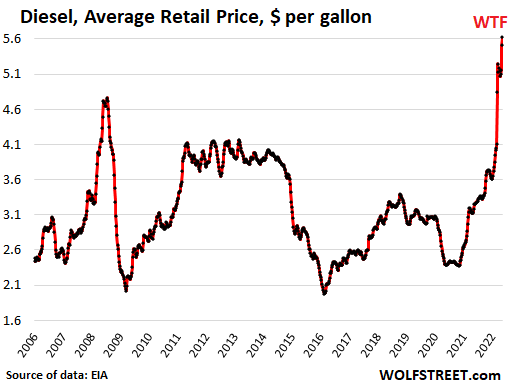Signs of a Downshift in the Freight Cycle, Trucking, and Demand
Amid constraints, shortages, and spiking diesel prices, freight volume slows, capacity opens up, freight rates may have peaked.
By Wolf Richter for WOLF STREET.
The crazy stimulus-fueled binge on goods in the US has been fading, as consumers are switching back to spending more money on discretionary services, where spending had collapsed during the pandemic, ranging from air fares to healthcare services. And there are still shortages of all kinds, preventing consumers and businesses from buying what they want, delaying construction projects, and forcing production cutbacks at manufacturing plants.
Ocean shipping is still in chaos, with container ships and containers hung up in various parts of the world. Finding containers to ship merchandise from the West Coast to Asia can be a nightmare. Portions of China, particularly Shanghai, that are critical for supplying the US with goods and components have been locked down, and shipments from there to the US have been seriously impacted. And pricing chaos reigns everywhere.
There are capacity constraints at US trucking companies and railroads. Inefficiencies due to the chaos have slowed everything down further.
Top this off with spiking prices for diesel, which this week hit a new record, and it creates a complex and very murky situation for transportation in the US.
Class 8 truck orders.
Heavy truck makers are sitting on large backlogs of orders for Class 8 trucks, and order books for 2022 are largely full, but they haven’t opened their order books for 2023, according to FTR Transportation Intelligence.
Truck makers are “carefully monitoring their backlogs and continuing to evaluate monthly how far into the future they are willing to push them,” FTR said in its note.
“As production continues to be significantly impacted by supply chain disruptions, component shortages, labor shortages, and increased material costs, the hesitancy to open 2023 order boards stems from not being able to guarantee pricing given the current environment,” FTR said.
“Once supply chain issues improve, OEMs will be able to substantially increase orders. But until then, conditions remain stagnant,” FTR said.
Orders for Class 8 trucks in April, at 15,400 orders, were down 56% year-over-year, according to data from FTR. The drop in orders reflects “a market that is trying to minimize its exposure to the headwinds it could potentially face in 2023,” FTR said.

Increasing uncertainties about demand.
The situation that heavy truck makers face is symptomatic for what is going on in this economy. There is still a lot of demand and limited capacity to fill that demand as these manufacturers are having trouble getting their parts and components, and they’re hampered by labor shortages. And chaos on the cost-side makes it risky to lock in prices for orders that cannot be produced for a while.
And these constraints are showing up in shipment volume, which has dropped from prior years, as we’ll see in a moment.
In addition, there is increasing uncertainty about demand in the future. Demand from consumers for goods has started to come off the stimulus-fueled spike, though it still remains above trend. Demand from industrial customers for transportation services is constrained by the supply chain chaos and the resulting limits on production.
Shipment volume fell.
Shipment volume in the US by all modes of transportation fell by 0.5% in April from April 2021, by 1.8% from April 2019, and by 5.0% from April 2018, according to the Cass Freight Index today.
The index covers all modes of transportation but is concentrated on trucking, with truckload shipments representing over half of the billings, rail in second place, less-than-truckload shipments in third place, followed by parcel services and others. It does not track shipments of bulk commodities.

Freight rates spike.
The combination of high demand, capacity constraints at transportation companies, and spiking fuel prices shows up in the ballooning amounts that shippers in aggregate are paying to send goods to their customers.
The Cass Freight Index for Inferred Freight Rates, which includes fuel surcharges and shows the overall movement in the costs of shipping, started spiking a year ago, and in April was up by 31% year-over-year. Compared to April 2019, it was up 58%.

Diesel prices spike.
The average price at the pump of No. 2 highway diesel in the US spiked to a record $5.62 a gallon on Monday, according to the EIA. Year-over-year, the price of diesel has spiked by 76%!

Expectations of a downshift in the freight cycle.
In February, the DAT’s Load-to-Truck ratio, which represents the number of loads posted for every truck on the DAT Load Boards, began declining, after the dizzying heights last year and the high in January of 9.3 loads for every truck. In March, the ratio was down to 4.6, and in April it fell to 3.4 loads per truck posted on the load boards.
Similarly, the Supply-Demand Balance in ACT Research’s for-hire survey got less tight earlier this year. In April, for the first time since June 2020, capacity to ship freight exceeded demand for shipping freight.
Similarly, average US spot rates for hauling van trailers, after rising to $3.10 per mile in January 2022, have declined, and in April dropped to $2.79 per mile, according to DAT.
Getting the transportation chaos sorted out, and having plenty of capacity to ship goods in the US, and perhaps even at flat or lower freight rates, would be a good thing for shippers, such as manufactures and retailers and their customers.
But given how cyclical the transportation business is, where capacity tends to materialize finally, just when demand is starting to slow, the trends of the past few months are “a sign for fleets to batten the hatches,” the report by Cass said. And these dynamics “strongly suggest” that freight rates might be coming off their dizzying spike.
Enjoy reading WOLF STREET and want to support it? Using ad blockers – I totally get why – but want to support the site? You can donate. I appreciate it immensely. Click on the beer and iced-tea mug to find out how:

Would you like to be notified via email when WOLF STREET publishes a new article? Sign up here.
![]()
[ad_2]
Source link


